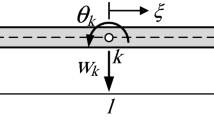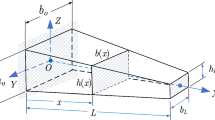Abstract
When dealing with the computation of bending frequencies for Timoshenko beams, it is common practice to assume a constant shear coefficient for a specific cross-sectional shape of the beam within the plane of bending vibration being considered. However, there have been various definitions, interpretations, and values assigned to it, depending on static and dynamic considerations, as well as experimental investigations, regardless of whether a wave approach or a mode approach is utilized. Currently, there is a lack of unanimity regarding the most suitable value for the shear coefficient. This study examines the impact of varying both the shear coefficient \(\kappa\) and the rotary inertia parameter \(\overline{r}_{{\text{g}}}\) on the first four bending modes of a uniform Timoshenko beam, considering numerous boundary conditions. The present numerical experiments reveal that increasing the shear coefficient tends to increase the frequency parameter values, while increasing the rotary inertia parameter is seen to decrease them. Both effects are very small at lower modes but become more pronounced at higher modes. The combined influence is seen to depress the frequency parameter values for all kinds of end conditions considered in this work.







Similar content being viewed by others
Abbreviations
- \(A\) :
-
Cross-sectional area of the beam
- \(\left[ B \right]\) :
-
Strain displacement matrix
- \(b\) :
-
Beam width
- \(E\) :
-
Modulus of elasticity
- \(G\) :
-
Modulus of rigidity
- \(h\) :
-
Beam height
- \(I\) :
-
Second moment of area
- \(i\) :
-
Mode number
- \(j\) :
-
Complex number \(= \sqrt { - 1}\)
- \(\left[ K \right]\) :
-
Stiffness matrix \(= \left[ {K_{{\text{e}}} } \right] + \left[ {K_{{\text{s}}} } \right]\)
- \(\left[ {K_{{\text{e}}} } \right]\) :
-
Elastic stiffness matrix
- \(\left[ {K_{{\text{s}}} } \right]\) :
-
Shear stiffness matrix
- \(\kappa\) :
-
Shear coefficient
- \(L\) :
-
Length of the beam
- \({\mathfrak{L}}\) :
-
Lagrangian
- \(\left[ M \right]\) :
-
Mass matrix \(= \left[ {M_{{\text{t}}} } \right] + \left[ {M_{{\text{r}}} } \right]\)
- \(\left[ {M_{{\text{t}}} } \right]\) :
-
Translational mass matrix
- \(\left[ {M_{{\text{r}}} } \right]\) :
-
Rotary inertia mass matrix
- \(\left[ {N_{w} } \right]\) :
-
Transverse displacement shape functions matrix
- \(\left[ {N_{\theta } } \right]\) :
-
Rotation shape functions matrix
- \(r_{{\text{g}}}\) :
-
Radius of gyration = \(\sqrt {{I \mathord{\left/ {\vphantom {I A}} \right. \kern-0pt} A}}\)
- \(\overline{r}_{{\text{g}}}\) :
-
Rotary inertia parameter (ratio of radius of gyration of section to beam length) \(= {{r_{{\text{g}}} } \mathord{\left/ {\vphantom {{r_{{\text{g}}} } L}} \right. \kern-0pt} L}\)
- \(Q\) :
-
Shear force
- \(\left\{ q \right\}\) :
-
Vector of nodal coordinates
- \(\left\{ {\overline{q}} \right\}\) :
-
Vector of displacement amplitudes of vibration
- \(s\) :
-
Slenderness ratio \(= {L \mathord{\left/ {\vphantom {L {r_{{\text{g}}} }}} \right. \kern-0pt} {r_{{\text{g}}} }}\)
- \(T\) :
-
Kinetic energy
- \(t\) :
-
Time
- \(U\) :
-
Strain energy
- \(\gamma\) :
-
Angle of distortion due to shear
- \(\varepsilon\) :
-
Normal strain
- \(\tau\) :
-
Shear strain
- \(\theta\) :
-
Rotation angle due to bending
- \(\nu\) :
-
Poisson’s ratio
- \(\rho\) :
-
Mass density
- \(\tau\) :
-
Shear stress
- \(\omega\) :
-
Natural frequency
- \(\overline{\omega }\) :
-
Frequency parameter \(= \omega L^{2} \sqrt {{{\rho A} \mathord{\left/ {\vphantom {{\rho A} {EI}}} \right. \kern-0pt} {EI}}}\)
- \(\overline{\omega }_{{\text{E}}}\) :
-
Euler–Bernoulli frequency parameter
- \(\overline{\omega }_{{\text{T}}}\) :
-
Timoshenko frequency parameter
- \(\eta\) :
-
Aspect ratio, (\(= {h \mathord{\left/ {\vphantom {h b}} \right. \kern-0pt} b}\), height/width)
- \(\zeta\) :
-
Non-dimensional length \(= {x \mathord{\left/ {\vphantom {x L}} \right. \kern-0pt} L}\)
- []T :
-
Transpose of []
References
Rayleigh, J.W.S.B.: The Theory of Sound. Macmillan, London (1877)
Timoshenko, S.P.: On the correction for shear of the differential equation for transverse vibration of prismatic bars. Philos. Mag. 41, 744–746 (1921). https://doi.org/10.1080/14786442108636264
Timoshenko, S.P.: On the transverse vibrations of bars of uniform cross-section. Philos. Mag. 43, 379–384 (1922). https://doi.org/10.1080/14786442208633855
Elishakoff, I.: Who developed the so—called Timoshenko beam theory? Math. Mech. Solids 25(1), 97–116 (2020). https://doi.org/10.1177/1081286519856931
Elishakoff, I.: Handbook on Timoshenko–Ehrenfest Beam and Uflyand–Mindlin Plate Theories. World Scientific, Singapore (2020). https://doi.org/10.1142/10890
Dym, C.L., Shames, I.H.: Solid Mechanics: A Variational Approach Augmented Edition. Springer, New York. https://doi.org/10.1007/978-1-4614-6034-3. ISBN: 978–1–4614–6034–3
Mindlin, R.D., Dersiewicz, H.: Timoshenko's shear coefficient for flexural vibrations of beams. In: Proceedings of 2nd U.S. National Congress of Applied Mechanics, pp. 175–178. ASME, New York (1954).
Pai, P.F., Schulz, M.J.: Shear correction factors and an energy-consistent beam theory. Int. J. Solids Struct. 36, 1523–1540 (1999). https://doi.org/10.1016/S0020-7683(98)00050-X
Sutherland, J.G., Goodman, L.E.: Vibrations of prismatic bars including rotatory inertia and shear corrections. Technical Report of a Cooperative Investigation with the Office of Naval Research, University of Illinois, Urbana, USA (1951). https://www.ideals.illinois.edu/items/13525
Goodman, L.E.: Discussion: Flexural vibrations in uniform beams according to the Timoshenko theory, by R. A. Anderson. Trans. ASME J. Appl. Mech. 21(2), 203–204 (1954). https://doi.org/10.1115/1.4010878
Stephen, N.G.: Timoshenko’s shear coefficient from a beam subjected to gravity loading. J. Appl. Mech. 47(1), 121–127 (1980). https://doi.org/10.1115/1.3153589
Dong, S.B., Alpdogan, C., Taciroglu, E.: Much ado about shear correction factors in Timoshenko beam theory. Int. J. Solids Struct. 47(13), 1651–1665 (2010). https://doi.org/10.1016/j.ijsolstr.2010.02.018
Rosinger, H.E., Ritchie, I.G.: On Timoshenko’s correction for shear in vibrating isotropic beams. J. Phys. D: Appl. Phys. 10(11), 1461–1466 (1977). https://doi.org/10.1088/0022-3727/10/11/009
Filon, L.N.G.: On an approximate solution for the bending of a beam of rectangular cross-section under any system of load, with special reference to points of concentrated or discontinuous loading. Proc. R. Soc. Lond 70, 459–466 (1902). https://doi.org/10.1098/rspl.1902.0050
Goens, V.E.: Uber die bestimmung des elastizitatsmodule von staben mit hilfe von biegungsschwingungen. Ann. Phys. Ser. 5(11), 649–678 (1931). https://doi.org/10.1002/andp.19314030602
Mindlin, R.D.: Influence of rotatory inertia and shear on flexural motions of isotropic elastic plates. J. Appl. Mech. 18(1), 31–38 (1951). https://doi.org/10.1115/1.4010217
Olsson, R.G.: Zur Berechnung der frequenz der transversalschwingungen des prismatischen stabes. Z. Angew. Math. und Mech. 15, 245–245 (1935). https://doi.org/10.1002/zamm.19350150410
Cowper, G.R.: The shear coefficient in Timoshenko’s beam theory. J. Appl. Mech. 33(2), 335–340 (1966). https://doi.org/10.1115/1.3625046
Stephen, N.G.: On the variation of Timoshenko’s shear coefficient with frequency. J. Appl. Mech. 45(3), 695–697 (1978). https://doi.org/10.1115/1.3424391
Stephen, N.G., Levinson, M.: A second order beam theory. J. Sound Vib. 67(3), 293–305 (1979). https://doi.org/10.1016/0022-460X(79)90537-6
Hutchinson, R.: Shear coefficients for Timoshenko beam theory. J. Appl. Mech. 68(1), 87–92 (2001). https://doi.org/10.1115/1.1349417
Faghidian, S.A.: Unified formulations of the shear coefficients in Timoshenko beam theory. J. Eng. Mech. 143(9), 06017013 (2017). https://doi.org/10.1061/(ASCE)EM.1943-7889.0001297
Chan, K.T., Lai, K.F., Stephen, N.G., Young, K.: A new method to determine the shear coefficient of Timoshenko beam theory. J. Sound Vib. 330, 3488–3497 (2011). https://doi.org/10.1016/j.jsv.2011.02.012
Kim, J.G., Lee, J.K., Yoon, H.J.: On the effect of shear coefficients in free vibration analysis of curved beams. J. Mech. Sci. Technol. 28(8), 3181–3187 (2014). https://doi.org/10.1007/s12206-014-0727-9
Kaneko, T.: On Timoshenko’s correction for shear in vibrating beams. J. Phys. D Appl. Phys. 8, 1927–1936 (1975). https://doi.org/10.1088/0022-3727/8/16/003
Freund, J., Karakoç, A.: Shear and torsion correction factors of Timoshenko beam model for generic cross sections. Res. Eng. Struct. Mat. 2(1), 19–27 (2016). https://doi.org/10.17515/resm2015.19me0827
Kaneko, T.: An experimental study of the Timoshenko’s shear coefficient for flexurally vibrating beams. J. Phys. D Appl. Phys. 11(14), 1979–1988 (1978). https://doi.org/10.1088/0022-3727/11/14/010
Puchegger, S., Bauer, S., Loidl, D., Kromp, K., Peterlik, H.: Experimental validation of the shear correction factor. J. Sound Vib. 261(13), 177–184 (2003). https://doi.org/10.1016/S0022-460X(02)01181-1
Méndez-Sánchez, R.A., Morales, A., Flores, J.: Experimental check on the accuracy of Timoshenko’s beam theory. J. Sound Vib. 279(1–2), 508–512 (2005). https://doi.org/10.1016/j.jsv.2004.01.050
Franco-Villafañe, J.A., Méndez-Sánchez, R.A.: On the accuracy of the Timoshenko beam theory above the critical frequency: best shear coefficient. J. Mech. 32(5), 515–518 (2016). https://doi.org/10.1017/jmech.2015.104
Kawashima, H.: The shear coefficient for quartz crystal of rectangular cross section in Timoshenko’s beam theory. IEEE Trans. Ultrason. Ferroelectr. Freq. Control 43(3), 434–440 (1996). https://doi.org/10.1109/58.489402
Carnegie, W., Thomas, J.: The effects of shear deformation and rotary inertia on the lateral frequencies of cantilever beams in bending. ASME. J. Eng. Ind. 94(1), 267–278 (1972). https://doi.org/10.1115/1.3428121
Ghosh, N.G.: Research note: the effect of variation of shear stress factor on vibrating beams. J. Mech. Eng. Sci. 16(5), 346–348 (1974). https://doi.org/10.1243/JMES_JOUR_1974_016_062_02
Rossi, R.E., Laura, P.A.A., Maurizi, M.J.: Numerical experiments on the effect of the value of the shear coefficient upon the natural frequencies of a Timoshenko beam. J. Sound Vib. 154(2), 374–379 (1992). https://doi.org/10.1016/0022-460X(92)90590-T
Filipich, C.P., Rosales, M.B., Cortinez, V.H.: Natural frequencies of Timoshenko beam: exact values by means of a generalized solution. Mec. Comput. 14(1), 134–143 (1994)
Khan, M.U.: Vibration analysis of rotating tapered Timoshenko beam using Fourier-\(p\) superelement. Master Thesis, King Fahd University of Petroleum & Minerals, Dhahran, Saudi Arabia (2021)
Thomas, D.L., Wilson, J.M., Wilson, R.R.: Timoshenko beam finite elements. J. Sound Vib. 31(3), 315–330 (1973). https://doi.org/10.1016/S0022-460X(73)80276-7
Petyt, M.: Introduction to Finite Element Vibration Analysis, 2nd ed. Cambridge University Press, Cambridge (2010). ISBN 978-0-521-19160–9
Ginsberg, J.H.: Mechanical and Structural Vibrations: Theory and Applications. Wiley, New York (2001). ISBN: 978-0-471-37084-0
Wilkinson, J.H.: The Algebraic Eigenvalue Problem. Clarendon Press, Oxford (1965)
Wittrick, W.H., Williams, F.W.: A general algorithm for computing natural frequencies of elastic structures. Q. J. Mech. Appl. Math. 24(3), 263–284 (1971). https://doi.org/10.1093/qjmam/24.3.263
LAPACK 3.11.0 Linear Algebra PACKkage. https://www.netlib.org/lapack/explore-html/d8/d70/group__lapack.html. Accessed 14 June 2023
Murty, A.V.: Vibrations of short beams. AIAA J. 8(1), 34–38 (1970). https://doi.org/10.2514/3.5602
El Ouatouati, A., Johnson, D.A.: A new approach for numerical modal analysis using the element-free method. Int. J. Numer. Methods Eng. 46(1), 1–27 (1999). https://doi.org/10.1002/(SICI)1097-0207(19990910)46:1%3C1::AID-NME659%3E3.0.CO;2-G
Downs, B.: Reference frequencies for the validation of numerical solutions of transverse vibrations of non-uniform Beams. J. Sound Vib. 61(1), 71–78 (1978). https://doi.org/10.1016/0022-460X(78)90042-1
Davis, R., Henshell, R.D., Warburton, G.B.: A Timoshenko Beam Element. J. Sound Vib. 22(4), 475–487 (1972). https://doi.org/10.1016/0022-460X(72)90457-9
Dawe, D.J.: A finite element for the vibration analysis of Timoshenko beams. J. Sound Vib. 60(1), 11–20 (1978). https://doi.org/10.1016/0022-460X(78)90397-8
Downs, B.: Transverse vibration of a uniform, simply supported Timoshenko beam without transverse deflection. J. Appl. Mech. 43(4), 671–674 (1976). https://doi.org/10.1115/1.3423953
Bhashyam, G.R., Prathap, G.: The second frequency spectrum of Timoshenko beams. J. Sound Vib. 76(3), 407–420 (1981). https://doi.org/10.1016/0022-460X(81)90520-4
Acknowledgements
The support of King Fahd University of Petroleum & Minerals is greatly appreciated.
Author information
Authors and Affiliations
Corresponding author
Additional information
Publisher's Note
Springer Nature remains neutral with regard to jurisdictional claims in published maps and institutional affiliations.
Rights and permissions
Springer Nature or its licensor (e.g. a society or other partner) holds exclusive rights to this article under a publishing agreement with the author(s) or other rightsholder(s); author self-archiving of the accepted manuscript version of this article is solely governed by the terms of such publishing agreement and applicable law.
About this article
Cite this article
Bazoune, A. Combined influence of rotary inertia and shear coefficient on flexural frequencies of Timoshenko beam: numerical experiments. Acta Mech 234, 4997–5013 (2023). https://doi.org/10.1007/s00707-023-03648-6
Received:
Revised:
Accepted:
Published:
Issue Date:
DOI: https://doi.org/10.1007/s00707-023-03648-6




